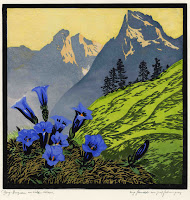Usually finding a new print by an unknown maker means investigating. Into the identity and/or the backgrounds of the artist. Recognizing the maker this time wasn't very difficult. The style is not to be mistaken. I have no particular criteria for buying a print other then I have to like it and on a limited bu
 dget, the price has to be fittingly. This recent find appealed to me very much because of the subject: the river/seaside and its strong geometrical composition. And most importantly, a fitting price. This kind of art, and the appreciation of it has fallen very much out of grace and fashion.
dget, the price has to be fittingly. This recent find appealed to me very much because of the subject: the river/seaside and its strong geometrical composition. And most importantly, a fitting price. This kind of art, and the appreciation of it has fallen very much out of grace and fashion.

 any influencial artists, painters, poets and writers of his time.
any influencial artists, painters, poets and writers of his time.
He also lived and studied in Brussels and Paris and very early in his career the incredibly wealthy industrial and art collector Anton Kröller and his wife Helène Kröller-Möller noticing his talent and bought his works. This famous art loving couple brought together the biggest Vincent van Gogh collection in the world thus leaving to the Nation a wonderful and world famous collection and the Kröller-Möller Museum of modern Art. More museums added his works into their collections during his life. He is also represented in many art collections in the Netherlands.
To observe and record daily life, harbour scenery and the riverside is what he liked and did best. The vaste delta of the river Rhine and Meuse meeting the Northsea with its busy ports, its long history of coastal defence and the struggle of men against the water is the recurring theme in much of his work. The opening picture (my new find) is a good example. Bought for only 10 bucks, it made me curious and wanting to find out more about Dirk Hidde Nijland.

In 1916 he was persuaded to try woodblock printing and only a year or two later he was published in Wendingen. This renowned art Magazine published by the Amsterdam society of archtitects ARCHITECTURA ET AMICITIA was to be devoted to architecture, construction and ornamentation. It was published, all by the same editor and designer from 1918 to 1925. The square lay out and wonderfully designed front covers now very sought-after by collectors and internationally famous for the Arts and Crafts, Art Deco, Jugendstil designs. In 1919 Dirk Hidde made his contributions for the special woodblock edition.
If you are interested have a look at: http://www.zuidelijkewandelweg.nl/architectuur/wendingen.htm
His work shows that he was a keen observer with a love
 for the land and people in his home and familiar environment.
for the land and people in his home and familiar environment.
These pictures showing he knew very well how to create depth, atmosphere and life into compositions of everyday scenes along the river in black and white according to the contemporary teachings of composition, technics and rules yet developing a strong and very personal style.













.jpg)

+.JPG)






























+antarctic+gulls.jpg)














